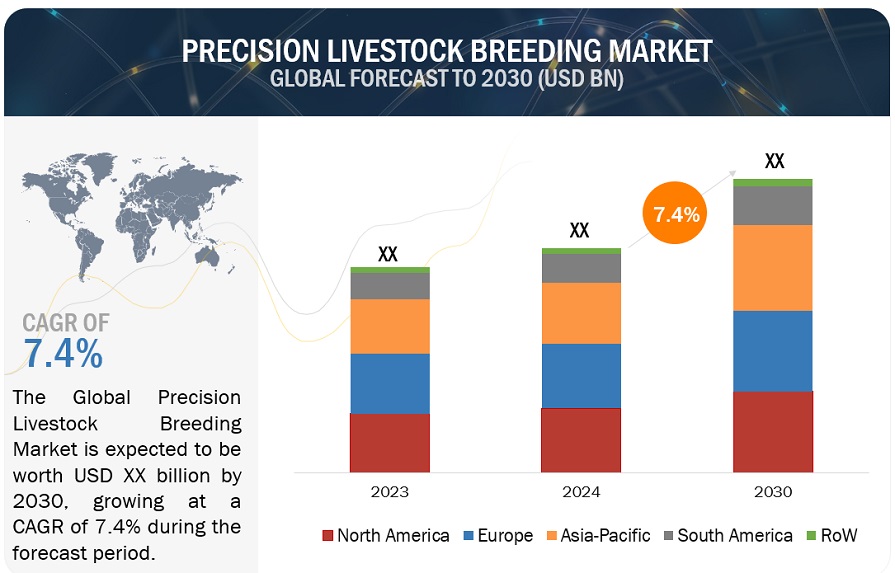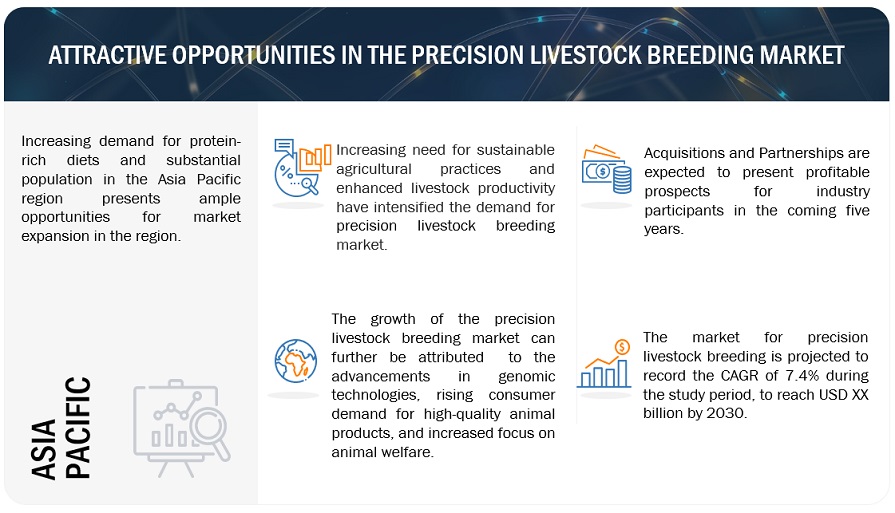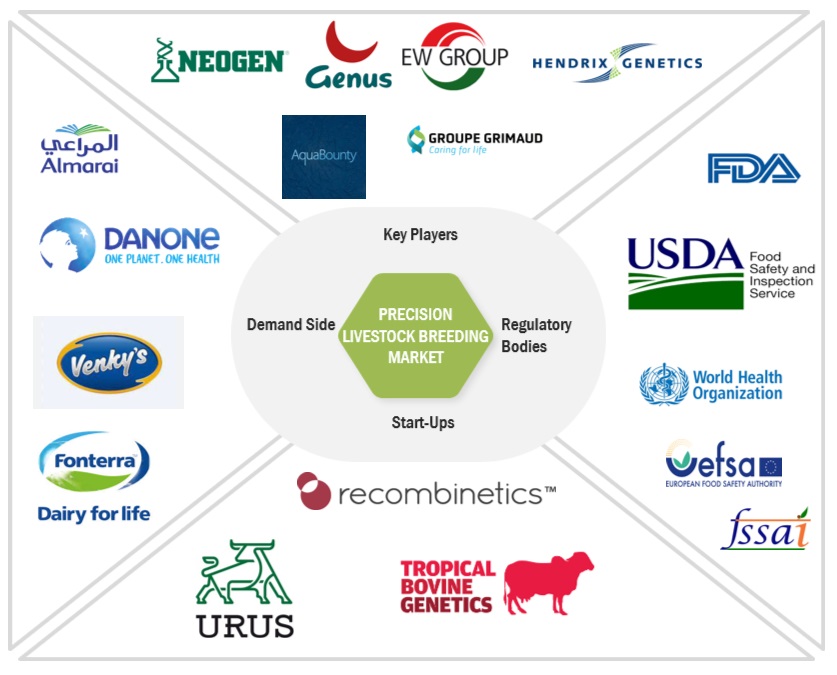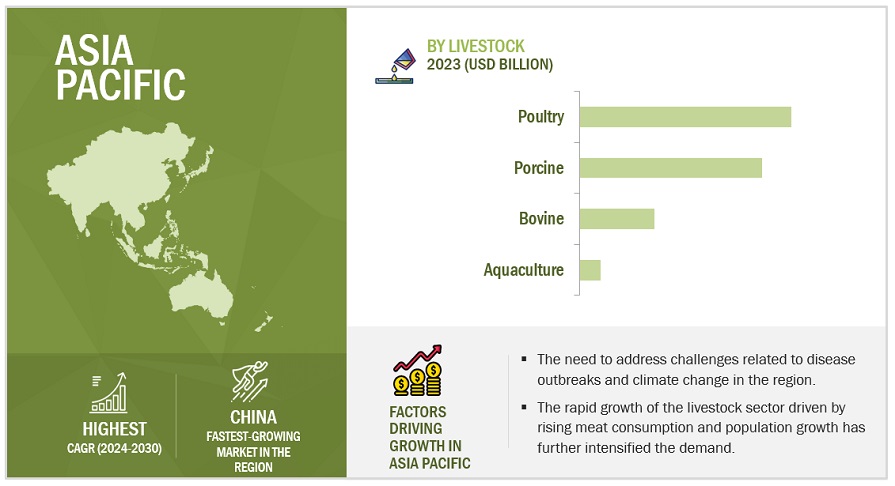Precision Livestock Breeding Market - Forecast to 2030
According to MarketsandMarkets, the precision livestock breeding market is projected to reach USD xx billion by 2030 from USD XX billion in 2024, at a CAGR of 7.4% during the forecast. Precision livestock breeding is also referred to as targeted breeding or gene editing in livestock. It is applied in the animal husbandry sector to create organisms with desired qualities. With the applications of gene modification technologies of CRISPR and TALENs, exact modifications can be made to an organism's DNA through precision livestock breeding. With the application of this technology, characteristics, including growth rate, meat quality, and resistance to disease, can be improved. It is also utilized to research and develop treatments for human ailments in model species like mice. This industry is driven by the rising need for efficient and sustainable livestock production.

To know about the assumptions considered for the study, Request for Free Sample Report

To know about the assumptions considered for the study, download the pdf brochure
Market Dynamics
Driver: Increasing demand for high-quality meat and dairy products
With the increase in global population, the demand for animal protein also rises. This high demand for meat drives the need for more efficient livestock production. To tackle this issue, precision breeding was introduced using gene modification enabling animals to grow faster and reach their market weight more quickly. This is especially important in species such as poultry, pigs, and fish, where faster growth translates directly into shorter production cycles and more protein produced in a shorter time. It can also lead to animal welfare leading to better productivity. It also reduces the usage of resources in breeding farm animals by reducing the pressure on land, water, and other resources as more meat can be made available per animal.
Restraints: Limited awareness
With the increase in global population, the demand for animal protein also rises. This high demand for meat drives the need for more efficient livestock production. To tackle this issue, precision breeding was introduced using gene modification enabling animals to grow faster and reach their market weight more quickly. This is especially important in species such as poultry, pigs, and fish, where faster growth translates directly into shorter production cycles and more protein produced in a shorter time. It can also lead to animal welfare leading to better productivity. It also reduces the usage of resources in breeding farm animals by reducing the pressure on land, water, and other resources as more meat can be made available per animal.
Opportunity: Increasing consumer demand for sustainable products
Precision breeding methods can be used to reduce methane emissions in ruminants like cows and sheep by selecting animals that produce less methane as a byproduct of digestion. This technology can help mitigate environmental concerns associated with meat production. This aids in helping livestock farming become more sustainable. Additionally, precision breeding can reduce the overall environmental impact of livestock production by creating animals that are more efficient at converting feed to protein. Fewer resources (land, water, and feed) are needed to produce the same amount of protein as the selectively bred organisms are efficient.
Challenge: Ethical concerns related to genetic modification and animal welfare
One of the biggest hurdles to commercial-scale precision breeding is regulatory approval, which varies significantly by country/region. For example, FDA approval of gene-edited hogs in the US took years and required substantial investment, demonstrating how the current system can hinder large-scale commercial adoption?. And in Europe, regulatory barriers are even stricter than any other region. The authorities in this region take a more precautionary approach to genetic modifications in animals, which limits the progress of commercializing gene-edited livestock?. challenges like these often reduce innovation and make it difficult for businesses to bring these technologies to market quickly.
PRECISION LIVESTOCK BREEDING MARKET ECOSYSTEM
Key players within this market consist of reputable and financially robust precision livestock breeding product manufacturers. These entities boast extensive industry tenure, offering diversified product portfolios, cutting-edge technologies, and robust global sales and marketing networks.

PORCINE, BY type, is the fastest growing segment among Precision livestock breeding type SEGMENT during the study period.
Precision breeding has been used to develop pigs resistant to Porcine Reproductive and Respiratory Syndrome. This has helped in significantly reducing the economic impact of the disease. Additionally, precision breeding can help combat other diseases like African swine fever and classical swine fever. These diseases have caused losses of millions in the livestock farming sector in the past. With technologies like Gene editing, feed conversion efficiency can be improved. This means that pigs grow faster and produce more meat with less feed. In addition, with improved feed efficiency, the environmental footprint of pig farming can also be reduced as fewer resources are being utilized. For these reasons, the porcine segment is estimated to be the fastest-growing segment.
ASIA PACIFIC is the fastest-growing MARKET FOR PRECISION LIVESTOCK BREEDING AMONG THE REGIONS.
The growing population of the Asia Pacific region is driving the increased consumption of meat, dairy, and fish, putting significant pressure on traditional farming systems. Precision breeding can help meet this demand by improving livestock and aquaculture productivity. The region's growing aquaculture sector is also demanding an increase in the efficiency of aqua protein production and reducing the usage of already scarce resources. Precision breeding can also help develop breeds that are more resilient to the impacts of climate change. For example, heat stress in cattle or drought tolerance in ruminants. This is crucial for regions like South Asia, where extreme weather events are increasingly affecting agricultural productivity.

Key Market Players
The key players in the precision livestock breeding market include Neogen Corporation (US), Hendrix Genetics BV (Netherlands), RECOMBINETICS (US), Genus (UK), URUS Group LP (US), AquaBounty Technologies, Inc. (US), EW Group (Germany), Groupe Grimaud (France), DanBred P/S (Denmark), and Tropical Animal Genetics (P) Ltd (India). These market participants are emphasizing the expansion of their footprint via partnerships and new product launches. They maintain a robust presence in North America, Europe, Asia Pacific, South America, and RoW, and they are supported by manufacturing facilities and well-established distribution networks spanning these regions.
Recent Developments
- In May 2022, Neogen Corporation (US) and Gencove (US) announced the launch of InfiniSEEK, a cost-effective solution for whole genome sequencing and targeted SNP analysis, designed to enhance cattle breeding programs. By integrating Neogen's genomic solutions with Gencove's low-pass sequencing and analytics software, InfiniSEEK offered a data-rich, accurate way to manage over 400 bovine genetic traits. This product launch strengthened Neogen's position in the precision livestock breeding market by providing a cutting-edge tool that improved genetic trait discovery and selection, potentially increasing the efficiency and profitability of breeding programs.
- In September 2021, Hendrix Genetics BV (Netherlands) partnered with Neogen Corporation (US) to enhance their Sustainable Access to Poultry Parent Stock in Africa (SAPPSA) program by incorporating genomic selection. This collaboration aimed to genotype elite animals in Hendrix Genetics' breeding program, ensuring that SASSO breeds are better adapted to the environmental conditions of Sub-Saharan Africa.
- In October 2020, Hendrix Genetics BV (Netherlands) announced an expansion with the establishment of a shrimp breeding centre in Indonesia. The new facility, PT Kona Bay Indonesia, aimed to produce over 100,000 specific pathogen-free (SPF) Vannamei shrimp annually, with operations initially based in West Java before moving to North Bali. This expansion enhanced Hendrix Genetics' market presence in Indonesia and strengthened its position by increasing production capacity and market reach.
Frequently Asked Questions (FAQ):
What is the current size of the precision livestock breeding market?
The precision livestock breeding market is estimated at USD XX billion in 2024 and is projected to reach USD XX billion by 2030, at a CAGR of 7.4% from 2024 to 2030.
Which are the key players in the market, and how intense is the competition?
The key players in the precision livestock breeding market include Neogen Corporation (US), Hendrix Genetics BV (Netherlands), RECOMBINETICS (US), Genus (UK), URUS Group LP (US), AquaBounty Technologies, Inc. (US), EW Group (Germany), Groupe Grimaud (France), DanBred P/S (Denmark), and Tropical Animal Genetics (P) Ltd (India).
The precision livestock breeding market has increased scope for growth, with an increase in the number of new product launches, acquisitions, and expansions. Moreover, companies involved in manufacturing precision livestock breeding products are investing a considerable proportion of their revenues in research and development activities.
Which region is projected to account for the largest share of the precision livestock breeding market?
The European market is expected to dominate during the forecast period. The increased demand for precision livestock breeding in the European region is driven by the European Union's rigorous regulations on animal welfare and environmental sustainability, which mandate more precise and efficient farming practices. Additionally, European countries' strong focus on reducing carbon footprints and enhancing food safety has accelerated the adoption of advanced genomic technologies in livestock breeding.
What kind of information is provided in the company profile section?
The company profiles mentioned above offer valuable information, such as a comprehensive business overview, including details on the company's various business segments, financial performance, geographical reach, revenue composition, and revenue breakdown. Additionally, these profiles offer insights into the company's product offerings, significant milestones, and expert analyst perspectives to further explain the company's potential.
What are the factors driving the precision livestock breeding market?
The demand for precision livestock breeding is primarily driven by Increasing demand for high-quality meat and dairy products and technological advancements & growing R&D activities. .
To speak to our analyst for a discussion on the above findings, click Speak to Analyst
















Growth opportunities and latent adjacency in Precision Livestock Breeding Market